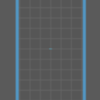Thanks Mark and everyone! Yes… it's coming along. Today was a mixed bag of picking up the ancillary items I need for the printer and doing some engine house work.
This morning the exterminator came for our quarterly visit, so I was downstairs with him just puttering around. I decided to see how the completed roof fit with the walls. Remember, I was worried that those butt joints would be weak. Two of the four pieces discombobulated before I even got it to the building from its own weight. Later today I added carbon fiber tape which helped a lot, but even that isn't really strong enough, so the last thing I did was add a piece of thin ply. Really all the joints need this form of strengthening. When the roof is on the building supported all over the place, the weakness won't matter, but it does when you try and life it.
I finished up both ends. So the interior is now ready for paint. So to answer Donald's question, I'm painting the interior when the walls are separate. It will be a two-tone affair with white up about 6 scale feet and the rest a light gray, both using Rust-O-Leum rattle can enamel. Weather tomorrow should be dry. I will have to mask up and down all those wall protrusions.
Tonight I just put all the trusses on the buttresses to see how it looks. The trusses will be glued to the roof.
I finished the lathe redraw, exported it to an STL file and then imported it into the Elegoo ChiTuBox Slicer software. I processed very fast, but I think the object has translated as being very small, I mean infinitesimally small! I say this because using a 0.02mm layer thickness, it only seemed to have 20 layers. In fact, when I imported to the program, the platen field appeared to be empty. I had to zoom in and in until this little white speck showed up and then with continued zooming the lathe appeared. I need to do some more research to find out what's going on. The piece was so small that it would be produced with $0.00 worth of resin.
The extras I bought today are aluminum roasting pans to surround the unit to prevent resin spills on the workbench, disposal Rubbermaid containers for the alcohol rinses, a bigger funnel, and a new thumb drive. Generally, you convey the files to the printer via the thumb drive so you're not tying up your computer. I bought 190 proof grain alcohol at the liquor store that will be the resin rinse solvent. You can either use Iso or Ethanol, but I couldn't find Iso in 95% concentration, but 190 grain alcohol is 95%. Beside, if I get bored, I can mix a little in some fresh squeezed orange juice and have a screwdriver.
Last thing I did was make a dust/light cover for the unit out of the remains of the Amazon shipping carton. If you can keep all light off the resin tank, you can leave un-cured resin in the tank for the next time.
With the platen size of 2" X 4" I can print multiple parts in one go. Unlike a filament machine when the more stuff on the project, the slower the printer, with this concept, the entire layer is exposed simultaneously. Therefore, the only variable affecting speed is the layer thickness and the height of the object (how many layers are being printed). It is much faster than a filament machine. If I'm not mistaken, this technique first appeared in the press by a chemist who developed a light curing resin where it was all exposed in a full layer. His chemistry was more complicated involving oxygenation, and the units listed for $30,000. He was leasing the machines. They were 10X faster than machines that produced objects by writing single lines inscribing the object's parameters.
It's really the same technical leap that occurred when the dot matrix printer gave way to the laser printer, where the laser defined a single page in one go instead of writing a letter at a time. Even before that was the plotter where the pen had to literally draw every line in serial fashion.
I'm worried about the scale. The imported STL into the slicer seems to be tiny. The blue boundary is the platen and that tiny blue speck is the lathe. It's looks like a lathe for Z-gauge. I have to find out more about how all this works. Ironically, the printer will actually print that tiny thing.






